Signal Transduction Pathway: Clinical Applications and Research
VerifiedAdded on 2023/01/18
|6
|1683
|72
Essay
AI Summary
This essay explores the intricacies of signal transduction pathways, which are crucial for transferring chemical and physical signals to elicit cellular responses, primarily through protein phosphorylation by protein kinases. It details various pathways, including MAPK, JNK, ERK, and JAK-STAT, and their significance in treating critical diseases like cancer and autoimmune disorders. The essay highlights the JAK-STAT pathway as a primary therapeutic target, focusing on the use of JAK inhibitors such as Ruxolitinib and Oclacitinib, showcasing their effectiveness in treating myelofibrosis and atopic dermatitis, respectively. The essay also examines the clinical implications of MAPK pathway inhibitors in cancer treatment, particularly the role of HER2 and COX-2 in prostate cancer, as well as the role of p38MAPK in breast cancer metastasis and the potential of p38γ MAPK as a cancer therapy target. Furthermore, it discusses the significance of Syk signal transduction pathways in autoimmune and inflammatory diseases, emphasizing the potential of Syk inhibitors in treating Rheumatoid Arthritis. The essay concludes by underscoring the importance of signal transduction mechanisms in disease treatment and the potential of inhibiting these pathways to provide clinical benefits.

Running head: SIGNAL TRANSDUCTION PATHWAY
Signal Transduction Pathway
Name of the Student
Name of the University
Author Note
Signal Transduction Pathway
Name of the Student
Name of the University
Author Note
Paraphrase This Document
Need a fresh take? Get an instant paraphrase of this document with our AI Paraphraser
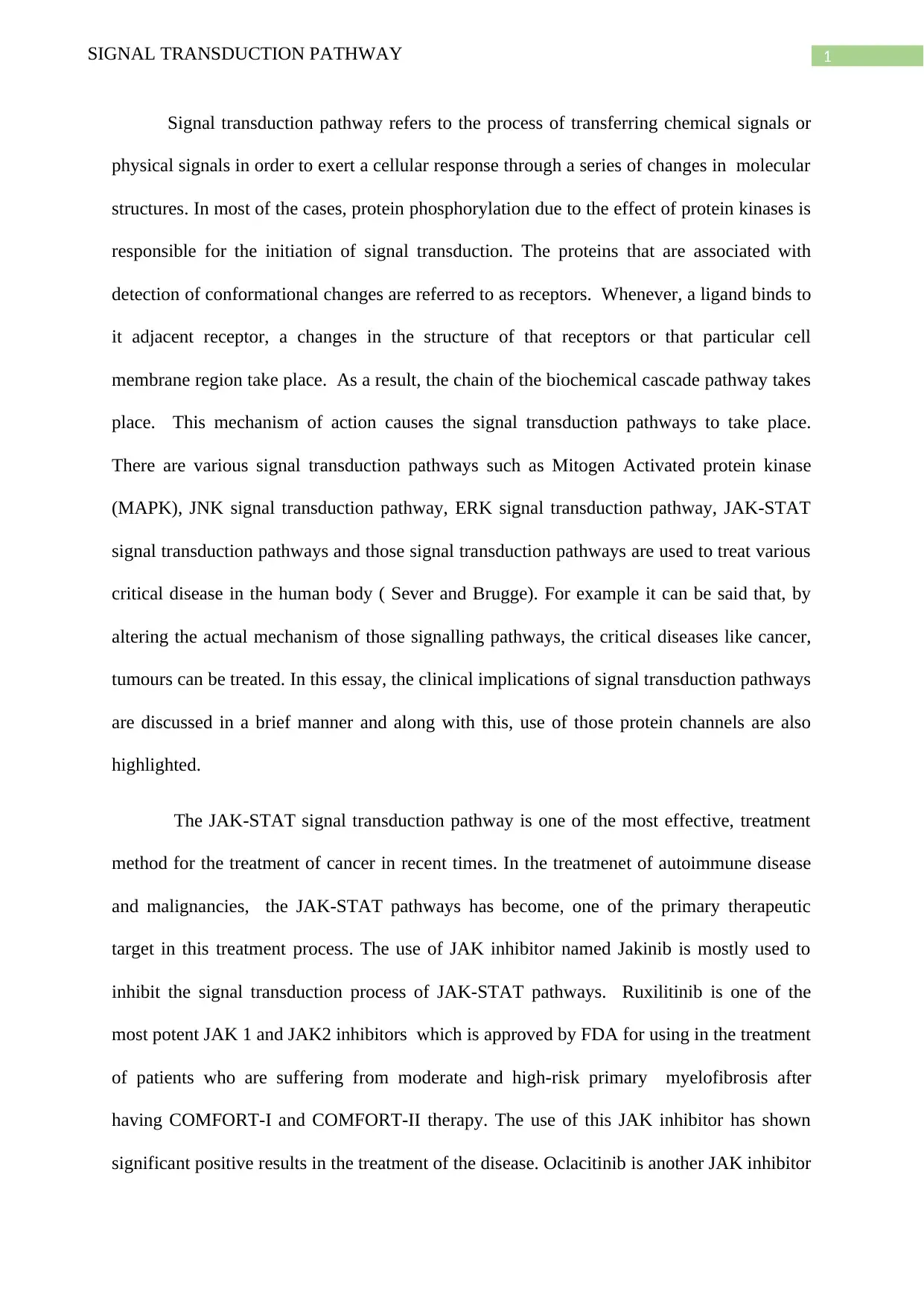
1SIGNAL TRANSDUCTION PATHWAY
Signal transduction pathway refers to the process of transferring chemical signals or
physical signals in order to exert a cellular response through a series of changes in molecular
structures. In most of the cases, protein phosphorylation due to the effect of protein kinases is
responsible for the initiation of signal transduction. The proteins that are associated with
detection of conformational changes are referred to as receptors. Whenever, a ligand binds to
it adjacent receptor, a changes in the structure of that receptors or that particular cell
membrane region take place. As a result, the chain of the biochemical cascade pathway takes
place. This mechanism of action causes the signal transduction pathways to take place.
There are various signal transduction pathways such as Mitogen Activated protein kinase
(MAPK), JNK signal transduction pathway, ERK signal transduction pathway, JAK-STAT
signal transduction pathways and those signal transduction pathways are used to treat various
critical disease in the human body ( Sever and Brugge). For example it can be said that, by
altering the actual mechanism of those signalling pathways, the critical diseases like cancer,
tumours can be treated. In this essay, the clinical implications of signal transduction pathways
are discussed in a brief manner and along with this, use of those protein channels are also
highlighted.
The JAK-STAT signal transduction pathway is one of the most effective, treatment
method for the treatment of cancer in recent times. In the treatmenet of autoimmune disease
and malignancies, the JAK-STAT pathways has become, one of the primary therapeutic
target in this treatment process. The use of JAK inhibitor named Jakinib is mostly used to
inhibit the signal transduction process of JAK-STAT pathways. Ruxilitinib is one of the
most potent JAK 1 and JAK2 inhibitors which is approved by FDA for using in the treatment
of patients who are suffering from moderate and high-risk primary myelofibrosis after
having COMFORT-I and COMFORT-II therapy. The use of this JAK inhibitor has shown
significant positive results in the treatment of the disease. Oclacitinib is another JAK inhibitor
Signal transduction pathway refers to the process of transferring chemical signals or
physical signals in order to exert a cellular response through a series of changes in molecular
structures. In most of the cases, protein phosphorylation due to the effect of protein kinases is
responsible for the initiation of signal transduction. The proteins that are associated with
detection of conformational changes are referred to as receptors. Whenever, a ligand binds to
it adjacent receptor, a changes in the structure of that receptors or that particular cell
membrane region take place. As a result, the chain of the biochemical cascade pathway takes
place. This mechanism of action causes the signal transduction pathways to take place.
There are various signal transduction pathways such as Mitogen Activated protein kinase
(MAPK), JNK signal transduction pathway, ERK signal transduction pathway, JAK-STAT
signal transduction pathways and those signal transduction pathways are used to treat various
critical disease in the human body ( Sever and Brugge). For example it can be said that, by
altering the actual mechanism of those signalling pathways, the critical diseases like cancer,
tumours can be treated. In this essay, the clinical implications of signal transduction pathways
are discussed in a brief manner and along with this, use of those protein channels are also
highlighted.
The JAK-STAT signal transduction pathway is one of the most effective, treatment
method for the treatment of cancer in recent times. In the treatmenet of autoimmune disease
and malignancies, the JAK-STAT pathways has become, one of the primary therapeutic
target in this treatment process. The use of JAK inhibitor named Jakinib is mostly used to
inhibit the signal transduction process of JAK-STAT pathways. Ruxilitinib is one of the
most potent JAK 1 and JAK2 inhibitors which is approved by FDA for using in the treatment
of patients who are suffering from moderate and high-risk primary myelofibrosis after
having COMFORT-I and COMFORT-II therapy. The use of this JAK inhibitor has shown
significant positive results in the treatment of the disease. Oclacitinib is another JAK inhibitor
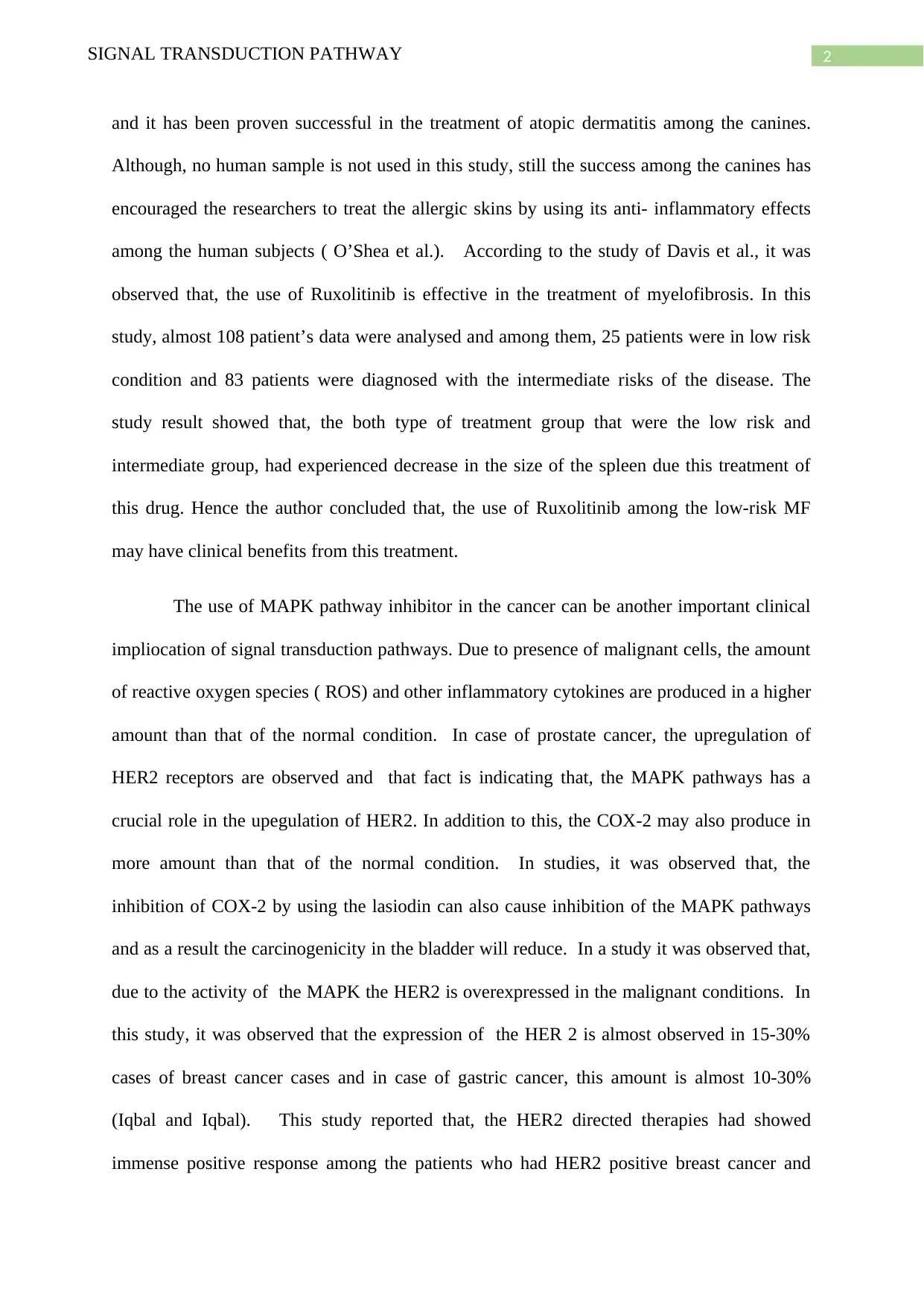
2SIGNAL TRANSDUCTION PATHWAY
and it has been proven successful in the treatment of atopic dermatitis among the canines.
Although, no human sample is not used in this study, still the success among the canines has
encouraged the researchers to treat the allergic skins by using its anti- inflammatory effects
among the human subjects ( O’Shea et al.). According to the study of Davis et al., it was
observed that, the use of Ruxolitinib is effective in the treatment of myelofibrosis. In this
study, almost 108 patient’s data were analysed and among them, 25 patients were in low risk
condition and 83 patients were diagnosed with the intermediate risks of the disease. The
study result showed that, the both type of treatment group that were the low risk and
intermediate group, had experienced decrease in the size of the spleen due this treatment of
this drug. Hence the author concluded that, the use of Ruxolitinib among the low-risk MF
may have clinical benefits from this treatment.
The use of MAPK pathway inhibitor in the cancer can be another important clinical
impliocation of signal transduction pathways. Due to presence of malignant cells, the amount
of reactive oxygen species ( ROS) and other inflammatory cytokines are produced in a higher
amount than that of the normal condition. In case of prostate cancer, the upregulation of
HER2 receptors are observed and that fact is indicating that, the MAPK pathways has a
crucial role in the upegulation of HER2. In addition to this, the COX-2 may also produce in
more amount than that of the normal condition. In studies, it was observed that, the
inhibition of COX-2 by using the lasiodin can also cause inhibition of the MAPK pathways
and as a result the carcinogenicity in the bladder will reduce. In a study it was observed that,
due to the activity of the MAPK the HER2 is overexpressed in the malignant conditions. In
this study, it was observed that the expression of the HER 2 is almost observed in 15-30%
cases of breast cancer cases and in case of gastric cancer, this amount is almost 10-30%
(Iqbal and Iqbal). This study reported that, the HER2 directed therapies had showed
immense positive response among the patients who had HER2 positive breast cancer and
and it has been proven successful in the treatment of atopic dermatitis among the canines.
Although, no human sample is not used in this study, still the success among the canines has
encouraged the researchers to treat the allergic skins by using its anti- inflammatory effects
among the human subjects ( O’Shea et al.). According to the study of Davis et al., it was
observed that, the use of Ruxolitinib is effective in the treatment of myelofibrosis. In this
study, almost 108 patient’s data were analysed and among them, 25 patients were in low risk
condition and 83 patients were diagnosed with the intermediate risks of the disease. The
study result showed that, the both type of treatment group that were the low risk and
intermediate group, had experienced decrease in the size of the spleen due this treatment of
this drug. Hence the author concluded that, the use of Ruxolitinib among the low-risk MF
may have clinical benefits from this treatment.
The use of MAPK pathway inhibitor in the cancer can be another important clinical
impliocation of signal transduction pathways. Due to presence of malignant cells, the amount
of reactive oxygen species ( ROS) and other inflammatory cytokines are produced in a higher
amount than that of the normal condition. In case of prostate cancer, the upregulation of
HER2 receptors are observed and that fact is indicating that, the MAPK pathways has a
crucial role in the upegulation of HER2. In addition to this, the COX-2 may also produce in
more amount than that of the normal condition. In studies, it was observed that, the
inhibition of COX-2 by using the lasiodin can also cause inhibition of the MAPK pathways
and as a result the carcinogenicity in the bladder will reduce. In a study it was observed that,
due to the activity of the MAPK the HER2 is overexpressed in the malignant conditions. In
this study, it was observed that the expression of the HER 2 is almost observed in 15-30%
cases of breast cancer cases and in case of gastric cancer, this amount is almost 10-30%
(Iqbal and Iqbal). This study reported that, the HER2 directed therapies had showed
immense positive response among the patients who had HER2 positive breast cancer and
⊘ This is a preview!⊘
Do you want full access?
Subscribe today to unlock all pages.

Trusted by 1+ million students worldwide
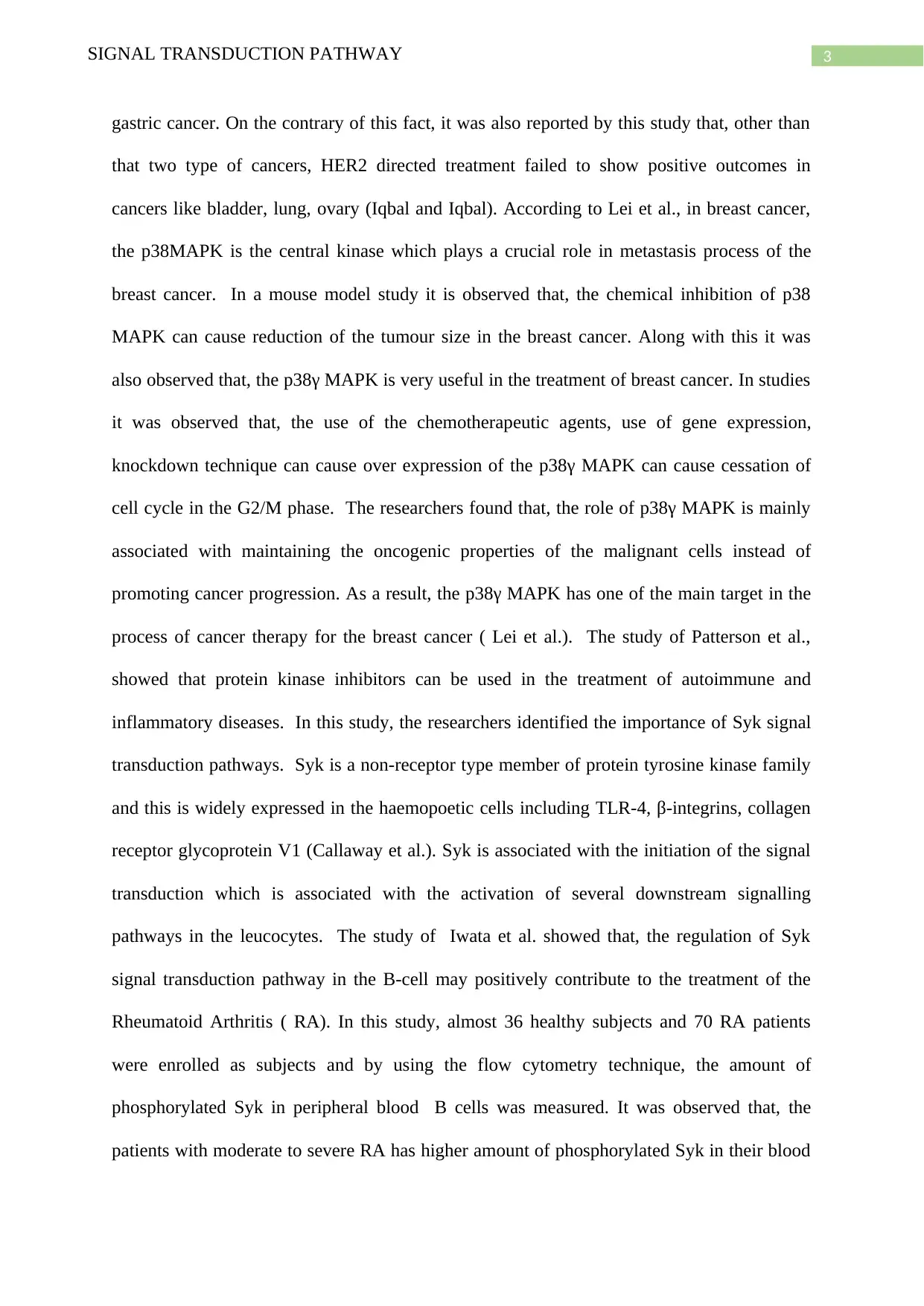
3SIGNAL TRANSDUCTION PATHWAY
gastric cancer. On the contrary of this fact, it was also reported by this study that, other than
that two type of cancers, HER2 directed treatment failed to show positive outcomes in
cancers like bladder, lung, ovary (Iqbal and Iqbal). According to Lei et al., in breast cancer,
the p38MAPK is the central kinase which plays a crucial role in metastasis process of the
breast cancer. In a mouse model study it is observed that, the chemical inhibition of p38
MAPK can cause reduction of the tumour size in the breast cancer. Along with this it was
also observed that, the p38γ MAPK is very useful in the treatment of breast cancer. In studies
it was observed that, the use of the chemotherapeutic agents, use of gene expression,
knockdown technique can cause over expression of the p38γ MAPK can cause cessation of
cell cycle in the G2/M phase. The researchers found that, the role of p38γ MAPK is mainly
associated with maintaining the oncogenic properties of the malignant cells instead of
promoting cancer progression. As a result, the p38γ MAPK has one of the main target in the
process of cancer therapy for the breast cancer ( Lei et al.). The study of Patterson et al.,
showed that protein kinase inhibitors can be used in the treatment of autoimmune and
inflammatory diseases. In this study, the researchers identified the importance of Syk signal
transduction pathways. Syk is a non-receptor type member of protein tyrosine kinase family
and this is widely expressed in the haemopoetic cells including TLR-4, β‐integrins, collagen
receptor glycoprotein V1 (Callaway et al.). Syk is associated with the initiation of the signal
transduction which is associated with the activation of several downstream signalling
pathways in the leucocytes. The study of Iwata et al. showed that, the regulation of Syk
signal transduction pathway in the B-cell may positively contribute to the treatment of the
Rheumatoid Arthritis ( RA). In this study, almost 36 healthy subjects and 70 RA patients
were enrolled as subjects and by using the flow cytometry technique, the amount of
phosphorylated Syk in peripheral blood B cells was measured. It was observed that, the
patients with moderate to severe RA has higher amount of phosphorylated Syk in their blood
gastric cancer. On the contrary of this fact, it was also reported by this study that, other than
that two type of cancers, HER2 directed treatment failed to show positive outcomes in
cancers like bladder, lung, ovary (Iqbal and Iqbal). According to Lei et al., in breast cancer,
the p38MAPK is the central kinase which plays a crucial role in metastasis process of the
breast cancer. In a mouse model study it is observed that, the chemical inhibition of p38
MAPK can cause reduction of the tumour size in the breast cancer. Along with this it was
also observed that, the p38γ MAPK is very useful in the treatment of breast cancer. In studies
it was observed that, the use of the chemotherapeutic agents, use of gene expression,
knockdown technique can cause over expression of the p38γ MAPK can cause cessation of
cell cycle in the G2/M phase. The researchers found that, the role of p38γ MAPK is mainly
associated with maintaining the oncogenic properties of the malignant cells instead of
promoting cancer progression. As a result, the p38γ MAPK has one of the main target in the
process of cancer therapy for the breast cancer ( Lei et al.). The study of Patterson et al.,
showed that protein kinase inhibitors can be used in the treatment of autoimmune and
inflammatory diseases. In this study, the researchers identified the importance of Syk signal
transduction pathways. Syk is a non-receptor type member of protein tyrosine kinase family
and this is widely expressed in the haemopoetic cells including TLR-4, β‐integrins, collagen
receptor glycoprotein V1 (Callaway et al.). Syk is associated with the initiation of the signal
transduction which is associated with the activation of several downstream signalling
pathways in the leucocytes. The study of Iwata et al. showed that, the regulation of Syk
signal transduction pathway in the B-cell may positively contribute to the treatment of the
Rheumatoid Arthritis ( RA). In this study, almost 36 healthy subjects and 70 RA patients
were enrolled as subjects and by using the flow cytometry technique, the amount of
phosphorylated Syk in peripheral blood B cells was measured. It was observed that, the
patients with moderate to severe RA has higher amount of phosphorylated Syk in their blood
Paraphrase This Document
Need a fresh take? Get an instant paraphrase of this document with our AI Paraphraser
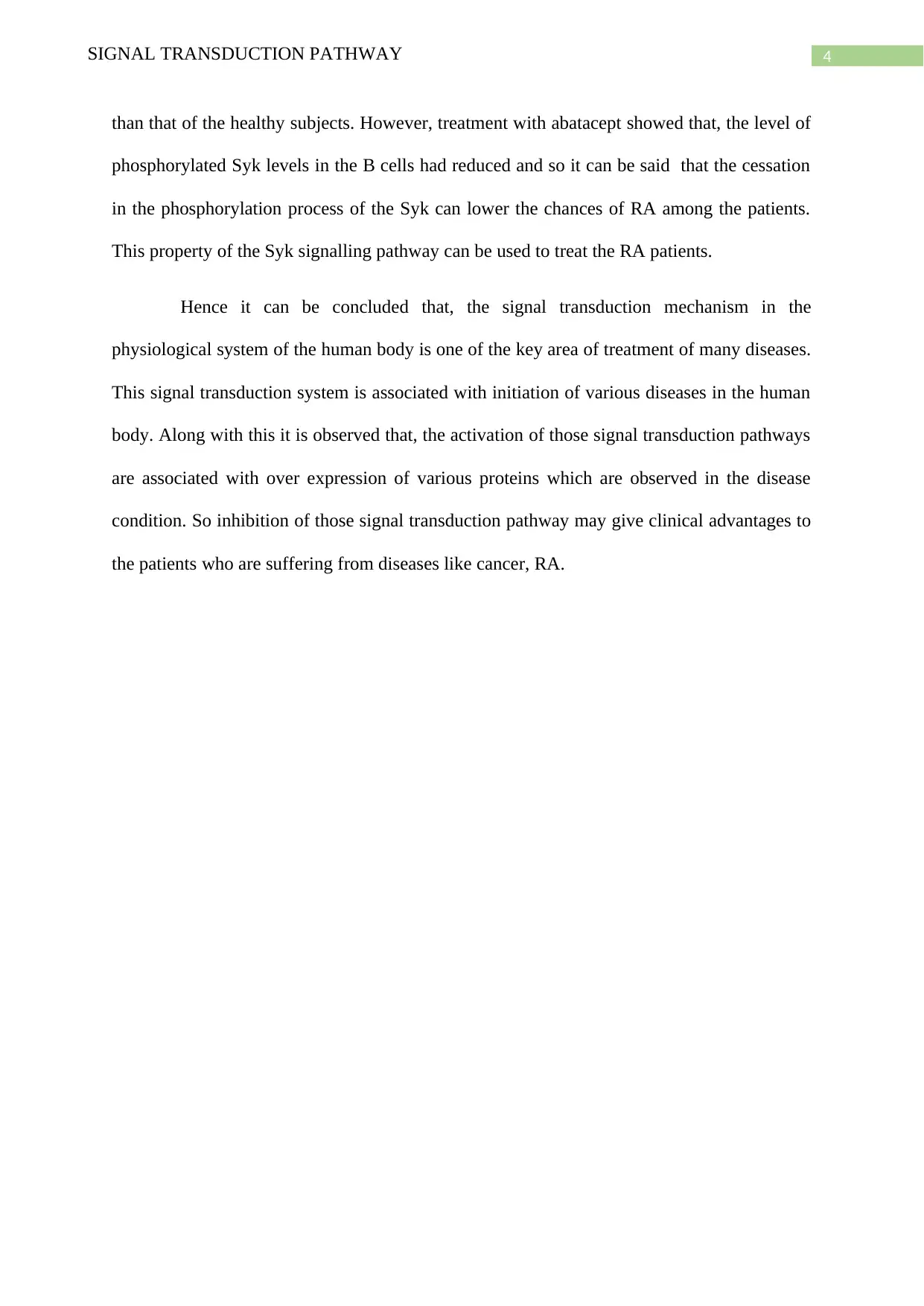
4SIGNAL TRANSDUCTION PATHWAY
than that of the healthy subjects. However, treatment with abatacept showed that, the level of
phosphorylated Syk levels in the B cells had reduced and so it can be said that the cessation
in the phosphorylation process of the Syk can lower the chances of RA among the patients.
This property of the Syk signalling pathway can be used to treat the RA patients.
Hence it can be concluded that, the signal transduction mechanism in the
physiological system of the human body is one of the key area of treatment of many diseases.
This signal transduction system is associated with initiation of various diseases in the human
body. Along with this it is observed that, the activation of those signal transduction pathways
are associated with over expression of various proteins which are observed in the disease
condition. So inhibition of those signal transduction pathway may give clinical advantages to
the patients who are suffering from diseases like cancer, RA.
than that of the healthy subjects. However, treatment with abatacept showed that, the level of
phosphorylated Syk levels in the B cells had reduced and so it can be said that the cessation
in the phosphorylation process of the Syk can lower the chances of RA among the patients.
This property of the Syk signalling pathway can be used to treat the RA patients.
Hence it can be concluded that, the signal transduction mechanism in the
physiological system of the human body is one of the key area of treatment of many diseases.
This signal transduction system is associated with initiation of various diseases in the human
body. Along with this it is observed that, the activation of those signal transduction pathways
are associated with over expression of various proteins which are observed in the disease
condition. So inhibition of those signal transduction pathway may give clinical advantages to
the patients who are suffering from diseases like cancer, RA.
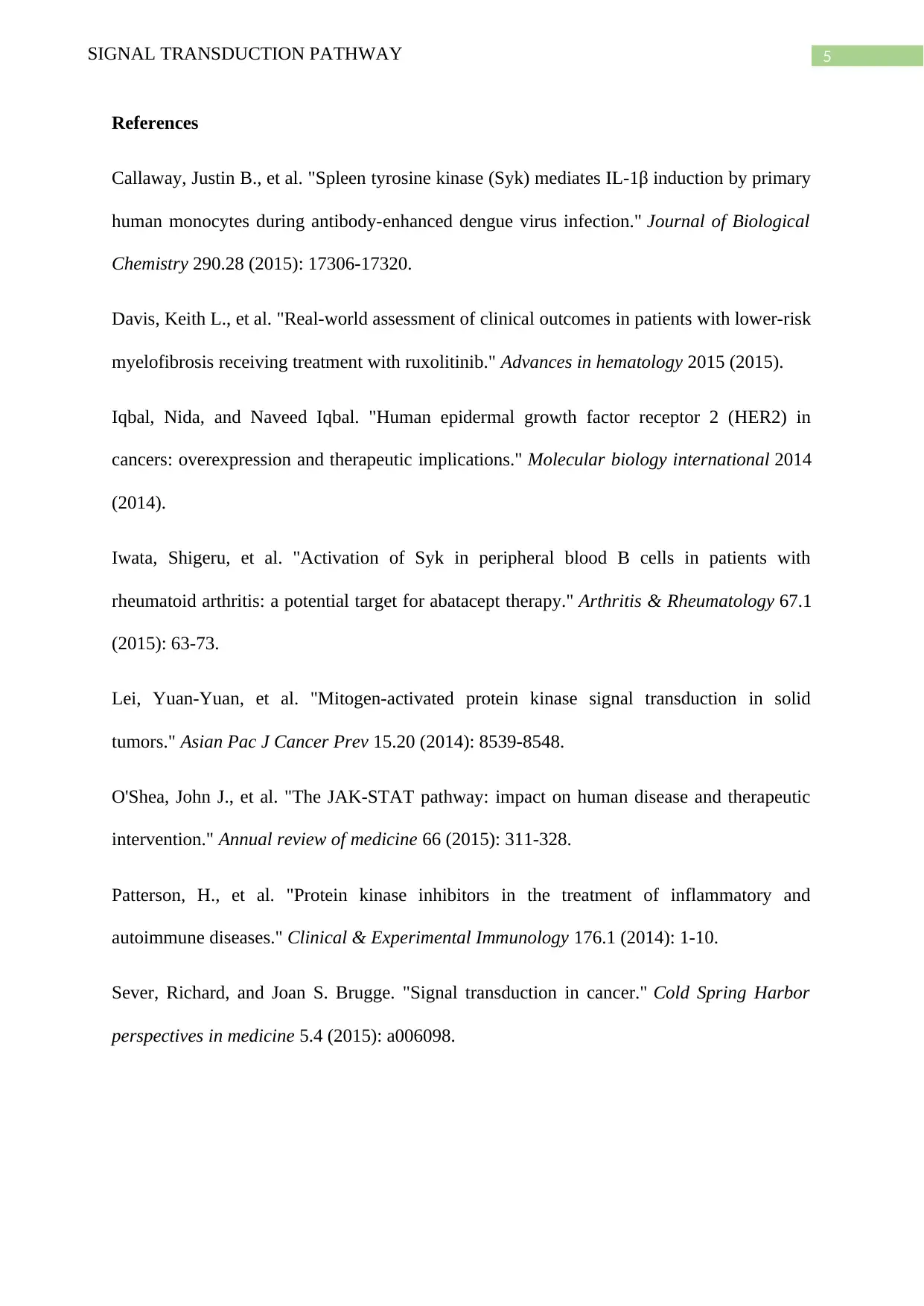
5SIGNAL TRANSDUCTION PATHWAY
References
Callaway, Justin B., et al. "Spleen tyrosine kinase (Syk) mediates IL-1β induction by primary
human monocytes during antibody-enhanced dengue virus infection." Journal of Biological
Chemistry 290.28 (2015): 17306-17320.
Davis, Keith L., et al. "Real-world assessment of clinical outcomes in patients with lower-risk
myelofibrosis receiving treatment with ruxolitinib." Advances in hematology 2015 (2015).
Iqbal, Nida, and Naveed Iqbal. "Human epidermal growth factor receptor 2 (HER2) in
cancers: overexpression and therapeutic implications." Molecular biology international 2014
(2014).
Iwata, Shigeru, et al. "Activation of Syk in peripheral blood B cells in patients with
rheumatoid arthritis: a potential target for abatacept therapy." Arthritis & Rheumatology 67.1
(2015): 63-73.
Lei, Yuan-Yuan, et al. "Mitogen-activated protein kinase signal transduction in solid
tumors." Asian Pac J Cancer Prev 15.20 (2014): 8539-8548.
O'Shea, John J., et al. "The JAK-STAT pathway: impact on human disease and therapeutic
intervention." Annual review of medicine 66 (2015): 311-328.
Patterson, H., et al. "Protein kinase inhibitors in the treatment of inflammatory and
autoimmune diseases." Clinical & Experimental Immunology 176.1 (2014): 1-10.
Sever, Richard, and Joan S. Brugge. "Signal transduction in cancer." Cold Spring Harbor
perspectives in medicine 5.4 (2015): a006098.
References
Callaway, Justin B., et al. "Spleen tyrosine kinase (Syk) mediates IL-1β induction by primary
human monocytes during antibody-enhanced dengue virus infection." Journal of Biological
Chemistry 290.28 (2015): 17306-17320.
Davis, Keith L., et al. "Real-world assessment of clinical outcomes in patients with lower-risk
myelofibrosis receiving treatment with ruxolitinib." Advances in hematology 2015 (2015).
Iqbal, Nida, and Naveed Iqbal. "Human epidermal growth factor receptor 2 (HER2) in
cancers: overexpression and therapeutic implications." Molecular biology international 2014
(2014).
Iwata, Shigeru, et al. "Activation of Syk in peripheral blood B cells in patients with
rheumatoid arthritis: a potential target for abatacept therapy." Arthritis & Rheumatology 67.1
(2015): 63-73.
Lei, Yuan-Yuan, et al. "Mitogen-activated protein kinase signal transduction in solid
tumors." Asian Pac J Cancer Prev 15.20 (2014): 8539-8548.
O'Shea, John J., et al. "The JAK-STAT pathway: impact on human disease and therapeutic
intervention." Annual review of medicine 66 (2015): 311-328.
Patterson, H., et al. "Protein kinase inhibitors in the treatment of inflammatory and
autoimmune diseases." Clinical & Experimental Immunology 176.1 (2014): 1-10.
Sever, Richard, and Joan S. Brugge. "Signal transduction in cancer." Cold Spring Harbor
perspectives in medicine 5.4 (2015): a006098.
⊘ This is a preview!⊘
Do you want full access?
Subscribe today to unlock all pages.

Trusted by 1+ million students worldwide
1 out of 6
Related Documents
Your All-in-One AI-Powered Toolkit for Academic Success.
+13062052269
info@desklib.com
Available 24*7 on WhatsApp / Email
![[object Object]](/_next/static/media/star-bottom.7253800d.svg)
Unlock your academic potential
Copyright © 2020–2025 A2Z Services. All Rights Reserved. Developed and managed by ZUCOL.





